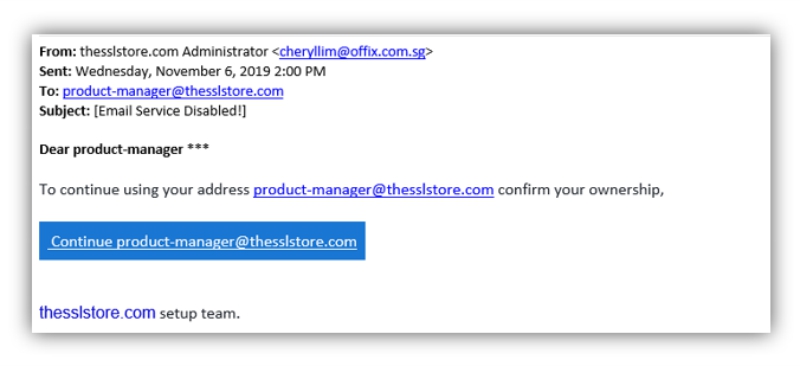Regardless of the sector, it is always possible to find people with bad intentions, who are always looking for ways to scam and carry out their fraud attempts. To do this, they use efficient methods and tools that are applied to make their attempts successful . In the digital scenario this is no different: one of the most commonly practiced scams today is called spoofing .
In a simplified way, spoofing refers to criminal behavior in the virtual environment, where the criminal team uses disguises in its approach so that its victim does something or provides information that will be used in a criminal manner .
Since digital security has been a widely discussed topic due to its importance, it is essential to understand how the main threats work so that we can combat them more efficiently. Want to better understand how Spoofing works? Check out this article in full and learn more about this threat!
What is Spoofing?
The origin of the term spoofing is in the English verb “spoof”, which means to pretend or imitate. In the technology sector, this term is used to refer to different types of counterfeiting, which can be directed at a person, website, server or service.
In short, Spoofing is the assertion that information is real and legitimate, when in fact it is not . To better exemplify this practice, imagine that you receive an email from a contact that is trustworthy or known, but that somehow seems suspicious.
Although the contact information such as name, header and email appears real, the content is dubious. This email often asks you to access suspicious links or provide information that is not really of interest to that contact . With this, we can suspect that this is an attempted spoofing attack.
Many people confuse the practice of spoofing with phishing due to some similarities between them . To clarify, we will address the differences between these two approaches throughout this article. But it is important to clarify that spoofing uses address masking to deceive its victims. Understand how this works: Spoofing
To be successful, the spoofing attack depends on the cybercriminal's ability to impersonate a company or person the victim trusts, simulating their contact information, such as their email address or telephone number . It tries to make you trust the legitimacy of this contact and provide confidential information that will be used to carry out future scams.
Although it has been a practice that has been applied for many years, the spoofing scam gained a lot of visibility in 2019, when the technique was used to hack political figures . The operation implemented by the Federal Police to identify the cybercriminals involved in the attack became known as Operation Spoofing.
The following year the maneuver gained even more popularity, reaching several people. Because of this, PROCON started issuing alerts to users who received calls from their own phone number in scam attempts.
How does Spoofing work in practice?
As we saw previously, cybercriminals try to impersonate a person or company to generate trust and, through this, manage to collect data in a criminal way. This approach can come from different channels, such as email, SMS and telephone.
To make it easier to understand, let's use the fake kidnapping scam as an example: in this case, the criminal tries to pretend to be a relative or acquaintance of the victim, informing that he is undergoing a kidnapping and that he will need to pay a rescue. But this kidnapping is fake.
In the case of spoofing, this threat occurs online. In the same way as in the example mentioned, cybercriminals use disguises to deceive their victims and convince them to provide confidential data , install malicious applications or induce them to carry out financial transactions.
As it is a strategy focused on disguising your intentions, this type of threat is very difficult to detect, which can cause great harm to victims.
Types of Spoofing
As we saw previously, the spoofing scam can be applied through different channels and resources. Below we will see the main ways that cybercriminals use to attack their victims:
Email spoofing
This is the most commonly used method of spoofing scam attempts. Typically, this type of scam involves requests for personal data or financial information, such as passwords and credit card numbers.
In order for the victim to believe in the legitimacy of the request, criminals seek to disguise themselves as reliable senders, familiar with or known to the victim. In this way, there is a presumption of legitimacy , which causes the user to provide the requested information without knowing that it is being forwarded to a criminal.
Another looming risk in email spoofing is the corrupted or malicious attachments that accompany it. These emails are often forwarding malware and viruses , which can harm the security of your devices and encourage the entry of hackers.
To be successful in their approach, cybercriminals use social engineering to reach their victims more efficiently . Do you know how social engineering applied to cyber attacks works? Check out this material and better understand this type of strategy.
IP spoofing
In the case of IP spoofing, the main focus is networks, not users, where the criminal seeks to gain access to a system. By sending messages using a disguised or fake IP , he tries to disguise himself as a user on the same network so that access is granted.
To make this possible, the cybercriminal uses a legitimate IP, changing the headers of the packets that are sent . This way, the requests appear to come from a trusted device.
Once he gains access, he can divert visitors from a legitimate page to a fraudulent website, enabling the collection of confidential information or the application of substantial financial scams. This approach is known as website spoofing.
DNS spoofing
This approach works similar to IP spoofing. However, in this case the cybercriminal seeks to manipulate network connections , also diverting user access from legitimate pages to fake websites.
Also known as cache poisoning, this type of cyber attack takes advantage of vulnerabilities in domain name servers to illegitimately divert real traffic to fake pages.
Call and SMS Spoofing
This attack is very simple to understand, as we become aware of several approaches of this type almost daily. Cybercriminals use calling, SMS or messaging platform services , posing as a legitimate company or contact as a way to carry out their scams.
Simply put, phone spoofing uses false caller ID to hide the true origin of a phone call . To do this, cybercriminals look for ways to make their number as similar as possible to the number of a real company. This way, the chances of the call being answered will be greater.
Spoofing vs Phishing
Phishing can be considered as an evolution of spoofing . Cybercriminals who carry out phishing scams often and deceive their victims, leading them to believe that the content or the contact attempt is legitimate.
We can understand spoofing as a more comprehensive technique, such as IP or DNS address spoofing. In this case, the criminal uses technical methods and tools to deceive not users, but a complete system or computer. For this reason, spoofing attacks and phishing are considered very similar approaches and are often used in conjunction.
Is it possible to protect yourself?
The first step to protecting yourself against cyber threats is to become aware of their existence and the need to implement security strategies and protocols.
It is extremely important to know what threats surround the digital world to be able to identify possible scams and fraud attempts. Although trust is a very positive aspect, overconfidence can lead us to suffer scams of different types , damaging the confidentiality of our information and favoring different types of threats.
In the case of spoofing, it is essential:
- Pay attention to the legitimacy of the emails that are received, as well as phone calls and SMS;
- Be very careful when accessing links in suspicious emails, as in most cases these links redirect to fake or fraudulent pages;
- Do not download attachments without prior analysis, as they may be contaminated files that harm the functioning of your device ;
- Security tools that help you increase the protection of your devices, such as antivirus and spam blockers , are essential.
Although IP spoofing is easier to identify, DNS spoofing is more difficult to combat, and some technical knowledge is required to avoid this type of scam . Learn how to check your router's DNS through this tutorial .
Another very important aspect is to be suspicious of requests made in emails, such as requests for personal documents, credit card numbers and passwords, security codes, among others . Whenever possible, try to activate two-step verification in your email services, preferably without using a phone number or SMS service as a second layer of security.
We have complete material to help you increase the security of your email, check it out here !
Lumiun Box : the ideal tool for companies
Aimed at companies, Lumiun Box can be the ideal tool for protecting organizations from spoofing and phishing . With solutions based on blocking internet access , Lumiun Box prevents malicious websites from being accessed, as well as malware files sent via email, for example. Furthermore, it is possible to determine access policies for certain groups, making the use of the company's internet network much safer and healthier .
See some benefits of using the solution in the business environment:
- Security
- Network firewall, protection against harmful websites, enterprise VPN and lower risk of information loss and viruses
- Productivity
- Control access! More focus on activities relevant to the company and less time wasted on the internet
- Cost reduction
- Reduced equipment maintenance costs, virus problems and wasted team time
- Information
- Graphs and reports of websites and services being accessed by employees
In addition to website blocking features, Lumiun Box has a few others, see:
- Enterprise Firewall;
- Business VPN;
- Management Reports;
- Traffic management;
You can see the characteristics of each of the features on the website www.lumiun.com/box box or by taking a free demonstration .
Don't just let luck protect your company's data and information. Use effective protection tools tailored to your needs .
Until later!










